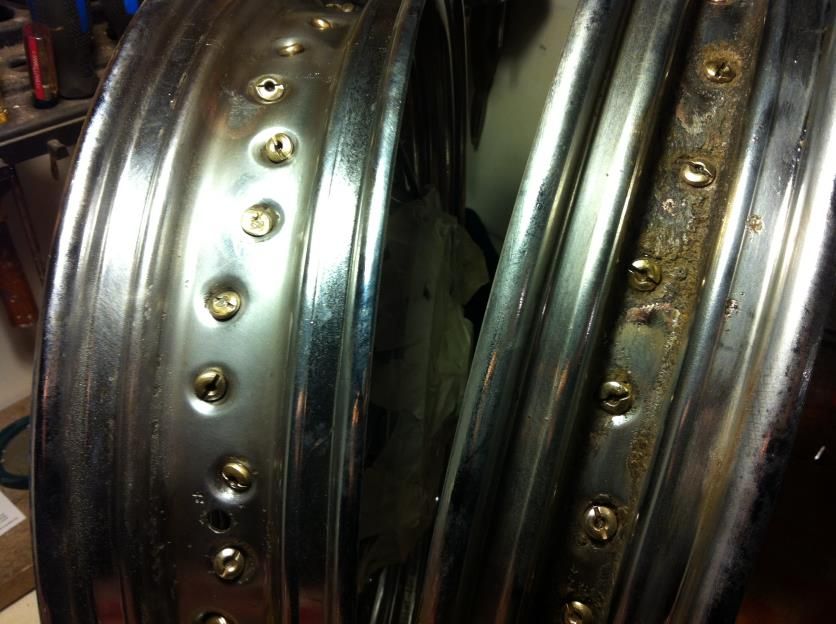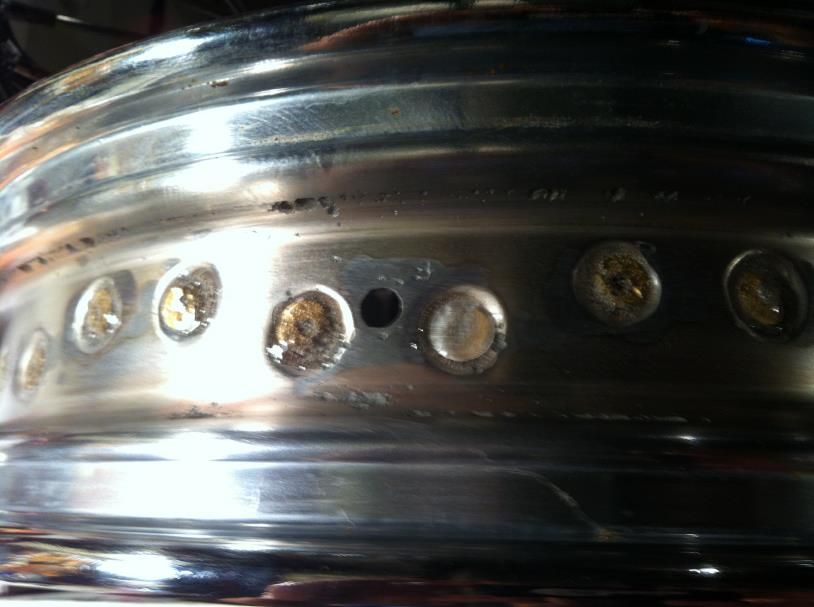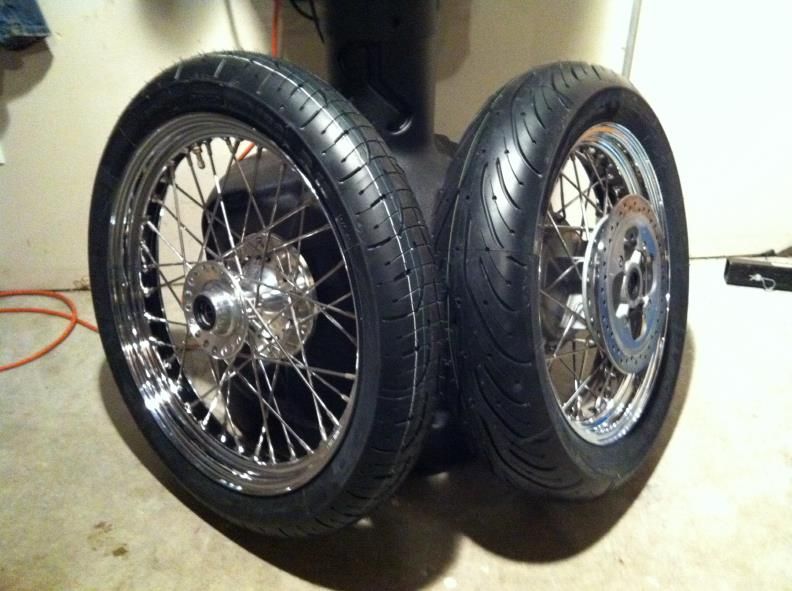Here's the follow up thread to one I posted a few months ago: "Anybody done a tubeless conversion with Seal All and Goop?"
This review is for anybody who's sick of running tubes and wants to try a DIY winter mod.
I'm going to be completely honest about what this entails, and I will also let you know if any failure emerges over time. And once Spring comes and I get rolling, I'll let you know whether I think there is an improvement that is worth the cost and hassle of this mod in how a Bonneville handles going from tubed Pirelli Sport Demon bias ply to tubeless Michelin PR4 radials.
It seems every year I take on a motorcycle related task that seems like a good idea but winds up taking WAYYY more time than I anticipate. This year was no different, but at least it gave me something to do over the Xmas break and provided me an excuse to be in the basement drinking beer, a safe distance from my in-laws.
The first thing you should know with our stock wheels on these bikes is, if they are a few years old, and if you have ridden in rain or even used a hose when washing your bike, you will have rust on the inside of the rims. Maybe a LOT of rust. If you're accustomed to riding in to a shop and magically riding out with new tires, there's going to be a surprise for you. I was too depressed to take a photo when I first got the tires off and had a look, but here's a pic AFTER I'd done a fair amount of rust dissolving and scrubbing with steel wool.

Eventually I stopped screwing around and rented space at a do-it-yourself bead blasting shop and in 15 min for 25 bucks I took it down to bare metal the sensible way.
I should say now the method I decided on to seal the wheels was a combination of Seal All and Outex tape. The Outex kit is not cheap costing around $125.00 US but I just wasn't brave enough to cut corners on this job. It's quite likely that you needn't bother with Seal All with the Outex kit but I wanted a little extra security. No matter what, you MUST do a very thorough job of cleaning the inside of the rims right down to wiping them with alcohol for the final step. The cleaner the better.

Getting the tape to adhere properly involves using a bench grinder to grind the heads of the spoke nipples so they are almost flush with the inside of the rim. Then I used a syringe to carefully drip Seal All into the nipple wells. I suspended the wheels with a wooden dowel between two sawhorses and did 4 nipples at a time so the Seal All sinks in and doesn't drip all over and make a mess. It's helpful to have a playoff game on TV to pause and go back and forth to while you're doing this (if you're obsessive enough to do this...) I did at least 3 applications to each nipple.
Here's what it looks like with the Seal All set. The one to the right of the valve hole has one of the caps that go on prior to applying the tape.

And here's with the Outex tape applied.

And finally, here's my decidedly "non-vintage looking" radial tires mounted on stock rims which I am delighted to report, hold air perfectly fine without tubes...so far. :smile2:

This review is for anybody who's sick of running tubes and wants to try a DIY winter mod.
I'm going to be completely honest about what this entails, and I will also let you know if any failure emerges over time. And once Spring comes and I get rolling, I'll let you know whether I think there is an improvement that is worth the cost and hassle of this mod in how a Bonneville handles going from tubed Pirelli Sport Demon bias ply to tubeless Michelin PR4 radials.
It seems every year I take on a motorcycle related task that seems like a good idea but winds up taking WAYYY more time than I anticipate. This year was no different, but at least it gave me something to do over the Xmas break and provided me an excuse to be in the basement drinking beer, a safe distance from my in-laws.
The first thing you should know with our stock wheels on these bikes is, if they are a few years old, and if you have ridden in rain or even used a hose when washing your bike, you will have rust on the inside of the rims. Maybe a LOT of rust. If you're accustomed to riding in to a shop and magically riding out with new tires, there's going to be a surprise for you. I was too depressed to take a photo when I first got the tires off and had a look, but here's a pic AFTER I'd done a fair amount of rust dissolving and scrubbing with steel wool.

Eventually I stopped screwing around and rented space at a do-it-yourself bead blasting shop and in 15 min for 25 bucks I took it down to bare metal the sensible way.
I should say now the method I decided on to seal the wheels was a combination of Seal All and Outex tape. The Outex kit is not cheap costing around $125.00 US but I just wasn't brave enough to cut corners on this job. It's quite likely that you needn't bother with Seal All with the Outex kit but I wanted a little extra security. No matter what, you MUST do a very thorough job of cleaning the inside of the rims right down to wiping them with alcohol for the final step. The cleaner the better.

Getting the tape to adhere properly involves using a bench grinder to grind the heads of the spoke nipples so they are almost flush with the inside of the rim. Then I used a syringe to carefully drip Seal All into the nipple wells. I suspended the wheels with a wooden dowel between two sawhorses and did 4 nipples at a time so the Seal All sinks in and doesn't drip all over and make a mess. It's helpful to have a playoff game on TV to pause and go back and forth to while you're doing this (if you're obsessive enough to do this...) I did at least 3 applications to each nipple.
Here's what it looks like with the Seal All set. The one to the right of the valve hole has one of the caps that go on prior to applying the tape.

And here's with the Outex tape applied.

And finally, here's my decidedly "non-vintage looking" radial tires mounted on stock rims which I am delighted to report, hold air perfectly fine without tubes...so far. :smile2:








